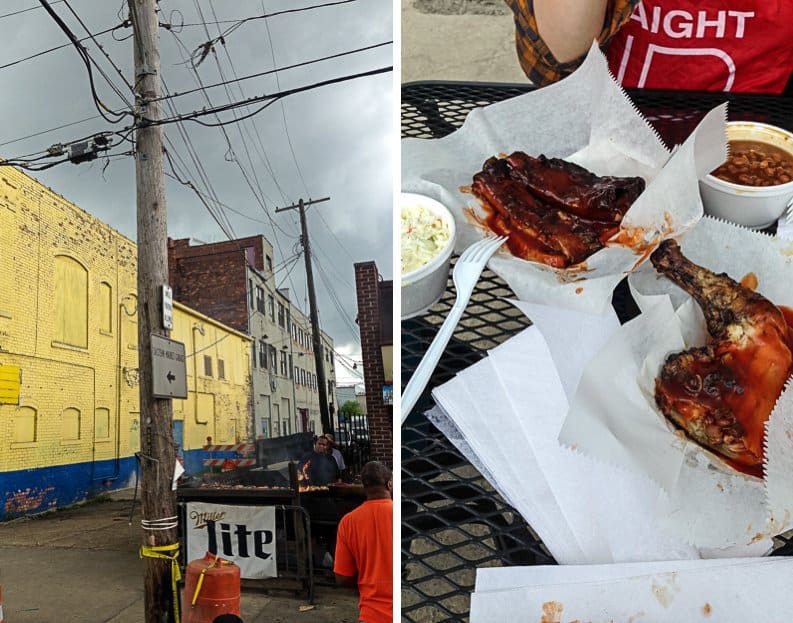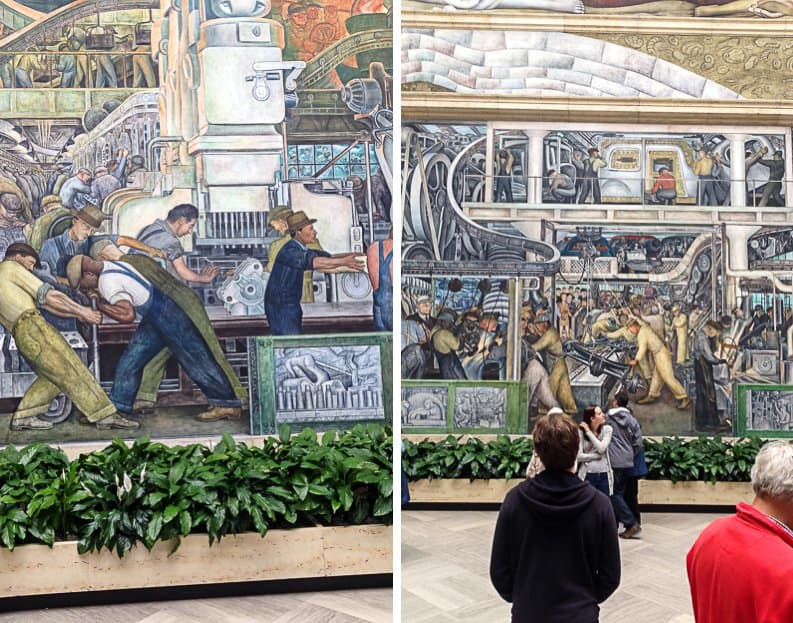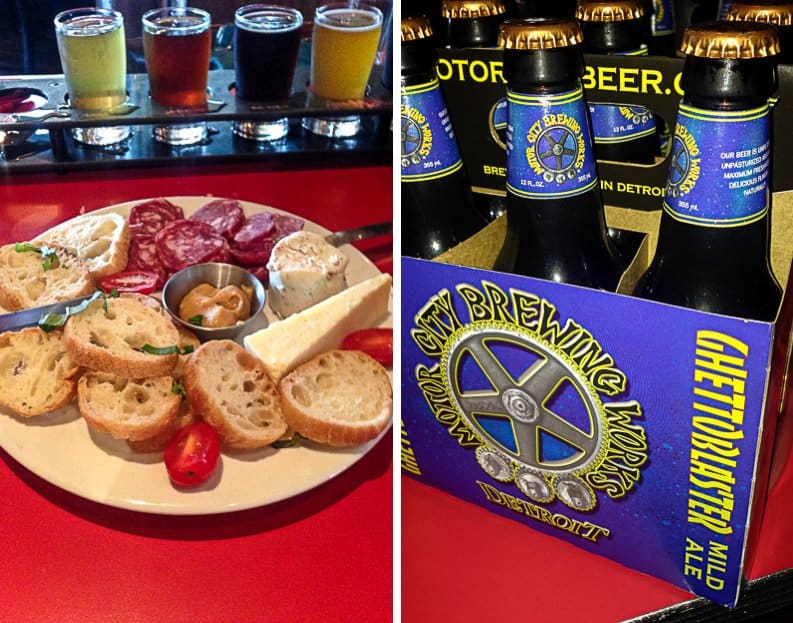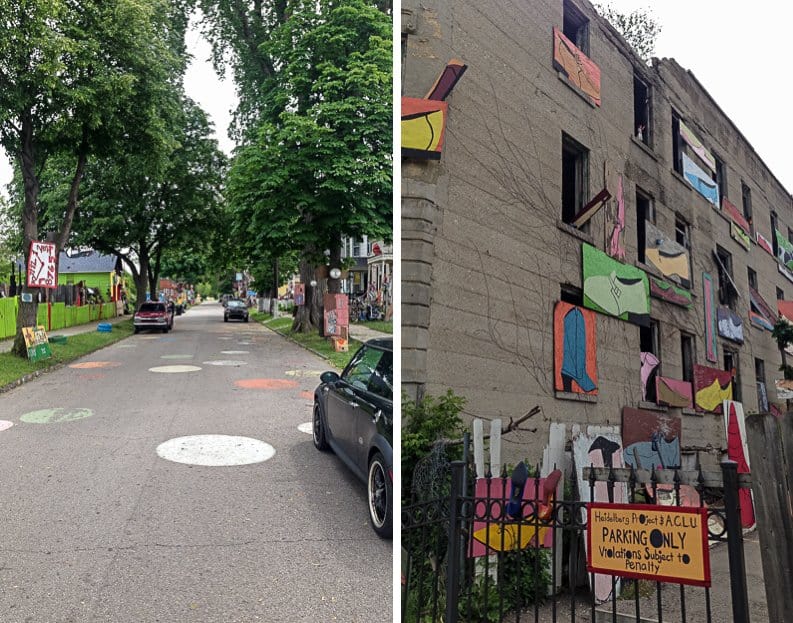13 Reasons Detroit Should Be Your Next Weekend Getaway
A guest post by Ashley White
When my German friend Lena, who lives in NYC, told me she wanted to make Detroit one of her US destinations before she left the continent, I was skeptical. Lena and I were roommates in Kabul, where we were both working for development agencies. We share eclectic ideas about what makes a great weekend getaway but…Detroit?
Detroit is derelict. Detroit is grimy. Detroit is hopeless.
Or so I thought.
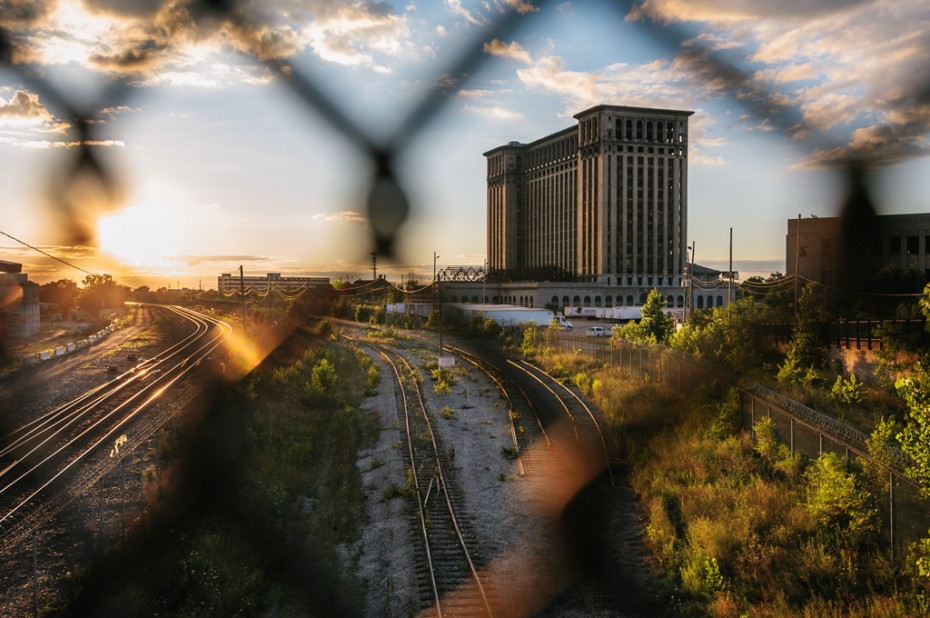
Michigan Central Stationg – Downtown Detroit (Photo Credit: Geoff Llerena)
Detroit is a city of insiders. Its rhythms and routes more clearly visible to residents than visitors, even those from other places in Michigan. It pulls makers and creatives from all over the country with its nominal housing prices and the grunting weight of those complicated, gritty human stories that force art to happen. Yet it retains a structural grace that betrays the millions of square feet of abandoned real estate.
Our trip was inspired by Susan Ager’s interactive National Geographic profile of the City. Lena flew in and myself and another friend, Erin, crossed the border at Windsor. The Border Patrol Officer raised both eyebrows when he realized we were tourists to Detroit. He actually said, “Why would you do that?” “Where are you staying? Who are you meeting? What do you do?” The story became even more implausible when we told him about Airbnb. He had never heard of Airbnb. He simply didn’t believe that we were staying in the home of a stranger in downtown Detroit. Eventually I snarked at him, “we’re interested in urban renewal.” This was not my first time getting lippy at a border crossing but I thought, ‘since when are Border Patrol Officers also travel tastemakers?’ He let us through and we picked up Lena at the Detroit Metropolitan Airport on a Saturday afternoon.
Don’t get too focused on an itinerary for your trip because you can fit a lot in on the fly. If you’re flying, rent a car. If you’re driving, get comfy. The roads in disrepair in some areas but nothing dangerous. Drive everywhere to make the weekend trip worthwhile. This is the Motor City.
Saturday Market at the Eastern Market
The Eastern Market (1445 Adelaide Street) is a 4.5-acre farmer’s market with specialty shops, antique shops and restaurants intermingling with pierogi sellers, purveyors of exotic succulents, lemonade stands and handcrafted soap exhibits. The Market is known as “the market that nourishes our city’s soul” and the emphasis is truly on growers, farmers and butchers. As soon as we popped out of the car, we saw our first East Side Rider standing beside his magnificent custom bicycle with its large ghetto blaster, pom-poms and all the chrome in the world. The Riders are a loosely associated group of Detroit residents who love custom bikes and love their neighborhoods. Detroit’s population shrank from 1 million, predominantly black, residents in 2007 to 500,000 residents today. The sparsely populated inner city means everyone has to travel farther for the basics and custom bikes have become an essential part of the transport infrastructure.
A little farther into the market is Bert’s Barbecue Smokehouse (2727 Russell Street), an outdoor/indoor joint with plastic tables crowding the sidewalks, live jazz and lemonade cocktails. Lena, Erin and I were enamored with the smoky, busy, trying-to-rain scene as we shamelessly gobbled extraordinary BBQ chicken and ribs, baked beans, slaw and fresh-squeezed vodka lemonades. We sipped, watched and slowed way the heck down.
I would have eaten fewer ribs had I known we were going to meet Allen and Donnie Love of Love’s Pie. An Eastern Market staple vendor, this couple makes custard pies in the southern tradition. I am not accustomed to such perfection in a pie, of which Travel Channel food critic Andrew Zimmern said, “It’s the best pie I have ever eaten in my life. It’s worth going just for that…” Our bellies were full but Allen convinced us to try a sample of the original Chess Pie, a sweet custard and buttery-crusted mouthful. We bought a pie. Each.
For apparel, the Eastern Market’s Division Street Boutique (1353 Division Street) developed street brand Detroit Hustles Harder to help support local artists. The Boutique feels like Detroit: spacious, tall and unpretentious. Hustling, indeed.
Casa Avery
Gary Schwartz and his partner, Cathy, moved to Detroit from Los Angeles fifteen years ago when Gary, an Academy Award-nominated animator, got a job as a college teacher. Now retired, the couple opens their century home to Detroit tourists year-round through Airbnb for $50 USD per night. They can host two guests at a time, but three if you bring an air mattress for an extra $10 USD per night. Gary and Cathy were laid-back and open to questions about their adopted home. They love Detroit, flaws and all, and see it like insiders.
After unpacking our Market wares and luggage at Casa Avery, we decided to walk to Corktown so I could imbibe during dinner. A neighborhood on the cusp of renewal, Corktown is a 30-minute walk from Casa Avery under normal conditions. But large lengths of sidewalks in the downtown core have been allowed to recede under heavy grass. Few people actually walk on the streets in Detroit because cycling or driving is faster and because many streets have no habitable buildings to drive pedestrian activity. With the striking downtown GM Renaissance Centre visible in the distance, we were marching single file through roadside grass fields in what was not even the most post-apocalyptic moment of our trip. Then we were caught in a torrential downpour. Imagine the only pedestrians on the street are three white women sprinting for many blocks – at least once in the wrong direction – towards their dinner, sopping wet, freezing cold and covered in grass, giggling like little kids at the improbability of it all.
Gold Cash Gold Detroit
Our ultimate destination was Gold Cash Gold Detroit (200 Michigan Ave), a renovated pawnshop and our first sighting of a crowd larger than two since the Market. “Where is everyone in Detroit?” we kept asking each other. A fair number were at Cash Gold Cash, a classy, busy joint dedicated to local food and artisan charcuterie. We were the wettest, coldest diners that evening, but servings of tangy Crispy Pig Ears and Saugatuck Starburst Wheat Ale made up the difference. For mains, I had the house-made pappardelle while Lena and Erin had the low-country cioppino, both of which were excellent. We Uber-ed back to Casa Avery at the end of the night, which is simpler than traditional taxis in Detroit.
The Hudson Cafe & The Detroit Institutes of Art Museum
On a gloomy Sunday morning, we drove to a quiet downtown Detroit to grab brunch before visiting the DIA’s Diego Rivera & Frida Kahlo in Detroit exhibit. The Hudson Cafe was among the few places open on a Sunday morning. It was packed with couples, families and college students awaiting their hardy breakfast fare that covered all the bases of classic American breakfasting. We were beginning to realize that Detroit happens inside, at least in the downtown. Our sense was that there would have been more pedestrian activity had the weather been brighter but not that much more.
The DIA’s Rivera & Kahlo Exhibit was dedicated to the years between 1930 and 1934 when Edsel Ford, Henry’s son, commissioned Rivera to paint epic murals dedicated to the early auto workers. Kahlo was Rivera’s unknown young wife but it was Detroit where she started to paint seriously after losing a child in utero. The exhibit is now over but the murals loom permanently in the Museum’s Courtyard. They depict the deep integration of men and machines at the time of Detroit’s birth as the Motor City. The murals and their roots particularly took Erin, a labor lawyer in Canada, in the global political economy – featuring the rise of socialism and industrialism – of the 1930s.
Motor City Brewing Works
The Works (470 West Canfield Street) is Detroit’s oldest working brewery, operating in Midtown on a street of posh lifestyle shops. The brewery’s Tap Room offers share plates, wood fired pizzas, tasting flights and pints. It’s a comfortable place that is serious about beer and about Detroit. We ordered a cheese plate and a tasting flight, but tours weren’t happening on Sundays. We left with two six-packs of their signature Ghettoblaster English Ale that they call “an on going documentation of the Detroit music scene”.
‘Parking Lot’ Theatre
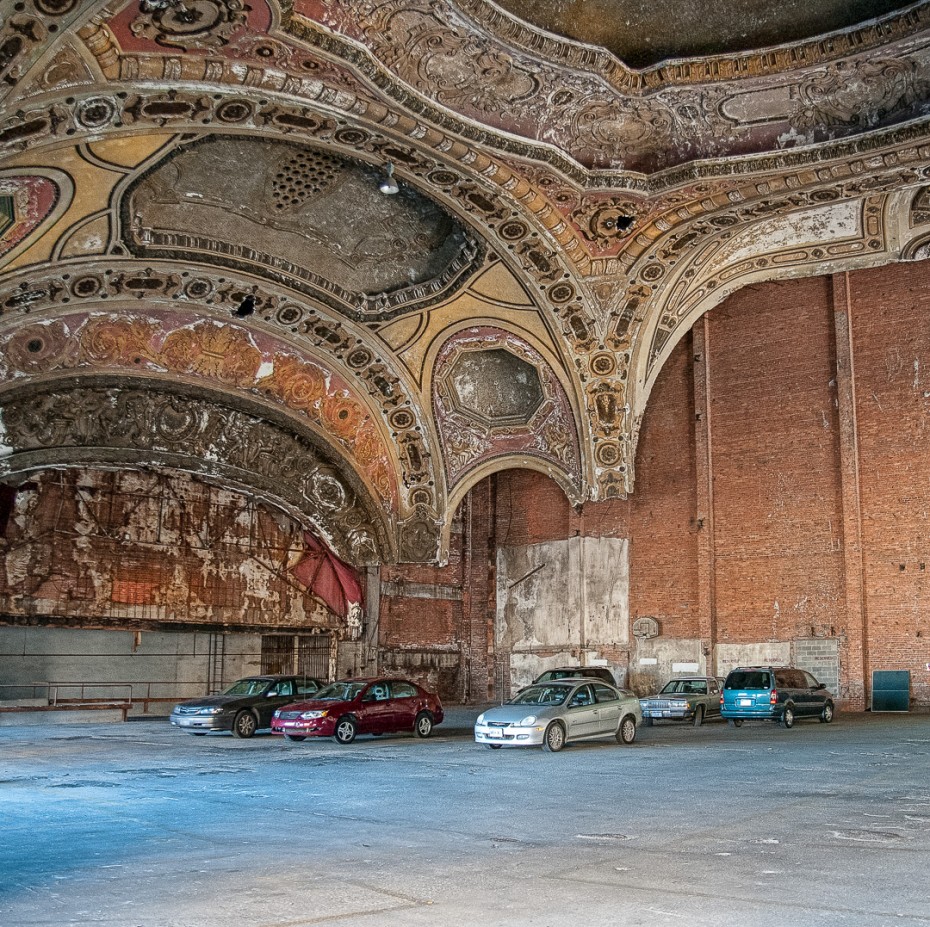
‘Parking Lot’ Theatre – Michigan Theatre, Detroit (Photo Credit: Bob Jagendorf)
The old Michigan Theatre, formerly a 4000-seat French Renaissance-style entertainment mecca, is now a parking lot. The theatre (36 Charles Street West) was built in the 1920s and spent 40 years as a premier global destination for orchestras, films and performance art. It was converted into a supper club for a hot second in the 1970s and then gutted for parking space in 1977. We spent almost an hour just trying to find the entrance. We pulled up behind an SUV parked in front of the entrance. On inspection, the SUV was rusted out and abandoned. Erin and Lena knocked on the gate to see if they could figure out how to get in and an attendant came out to see what we were on about. After hearing that we were tourists, he opened the gates and let us drive to the top floor. Faded glory is an expression that should be exclusively reserved for this particular building in this particular city. This was the most post-apocalyptic moment of our trip. We could all see exactly how prestigious the Michigan Theatre must have been which made its fall all the more regretful for us, in that moment, staring at the crusted molding and dulled crimson paint. We left distraught for Detroit. The attendant was nothing short of jolly. There was a Taylor Swift concert the night before at the neighboring Panasonic Theatre. He made a killing in tips.
Cliff’s Bells Supper Club
Tucked behind the Fox Theatre (2211 Woodward Ave) and Comerica Park (2100 Woodward Ave), Cliff’s Bells (2030 Park Ave) started out as a nomadic speakeasy during prohibition-era Detroit. The place is right out of the 1920s with low ceilings, dim lights, ornate wood paneling and maroon velvet walls. The center of the club is a large, glass bar with proper mixologists and almost a third of the lower floor is dedicated to a live music stage. The food and cocktails were on point, the jazz band was energetic and skilled, and we left satisfied by our first real supper club experience.
GM Renaissance Centre
A mammoth glass edifice staring down the Detroit River, the GM Ren Centre was built by Ford Motor Company and opened in 1976 and bought by General Motors in 1996. The Centre has hotels, bars, restaurants, and a movie theatre and is the global home of General Motors. Visit the RenCentre for the stellar sunset view of the River, to appreciate it as an architectural feat and because you, if you’re Canadian, you can get home carrier cell service from the upper floors.
As I was driving us back to Casa Avery that night, we saw five or six people walking in the middle of the road. It was really dark, many streetlights were out and one of the people was wearing a long black trench coat making him almost invisible to me. We knew about the state of the sidewalks but we didn’t think walking in the middle of the road was the answer. Cathy and Gary explained that, at night, it may actually be safer to walk in the middle of the road where no one can jump out of an alley and bring you harm.
Here’s the thing. Detroit doesn’t feel dangerous to us. Lena, Erin and I have travelled a lot and alone to far flung places with active conflict. We know what dangerous feels like and it’s terrible. But to see more than zero people walking in the middle of the road on a Sunday night told us that Detroit can feel dangerous to residents. This shouldn’t be a deterrent to taking in the city but it should be a reminder to use rational precautions. Drive very carefully to avoid hitting anyone and don’t take unnecessary risks.
Avalon International Breads
On our final morning in Detroit, we stopped for breakfast at Avalon International Breads (422 West Willis Street), an organic triple-bottom-line compliant bakery specializing in breads, baked sweets and quick savory bites. They’ve got free Wi-Fi, awesome coffee, a street patio and a love for Detroit’s people, artists and growers that seeps from the one-story brick building. The Avalon wholesales breads throughout Detroit so even if you don’t make it to the bakery – but you definitely should – you’ll probably sample some of their goods around the city.
The Heidelberg Project
If we thought we were starting to understand how painful the past 30 years have been for Detroit, the Heidelberg Project reminded us that we have absolutely no idea. Though renewal is starting, the process is bittersweet. Many are still excluded from participating in the City’s reinvention and the implications for Detroit’s social fabric are hard to appreciate as a tourist. The Heidelberg Project (Office: 42 Watson; Art: 3600 Heidelberg St.) is in its 30th year as an open-air art environment dedicated to art education, community development and creative tourism. We arrived mid-morning on a Monday without a tour and we were the only people on the block, other than a few city workers doing some landscaping.
Without context, the Project is bright in feel but dark in content. There is a fascinating industrial garden, large colored polka dots painted everywhere and an entire structure made from old LPs. But there are also mutilated plastic dolls, piles of filthy toys and houses on the verge of crumbling. For the Heidelberg Project, book a tour in advance on their website. We walked around perplexed, but so interested. We would have benefited from a narrative grounded in the experience of someone who understands Detroit.
Hope Takes Root
Cathy, from Casa Avery, runs this little co-operative garden with a few neighborhood friends. The co-operative feeds dozens of families on really cheap land and stands in profound contrast to the look and feel of the Heidelberg Project.
Mexicantown & Taqueria Lupitas
Before heading back to the airport and across the border, respectively, we stopped for lunch in Detroit’s Mexicantown. The neighborhood is small, nestled right up against the bridge to Canada and smells like churros, or sugary fried Mexican donuts, in late morning. Taqueria Lupitas (3443 Bagley Avenue) is very casual and very tasty. We had beef tongue, chorizo and shrimp tacos with a soupy guacamole and golden tortillas for less than $10 USD each.
Detroit is not a glamorous locale for a girls weekend getaway but it was easily the cheapest – and one of the most fun – travel weekends I’ve had in North America. Detroit remains on my mind, almost two months after our trip, because I can see it for what it was but have so many unanswered questions about what it is right now. It is bright and quiet, broken down and rebuilt, rich and poor, grand and lonely. Take in this place, a modern American story of punctuated redemption, without expectation or judgment and align your eyes not with the present, but with the possible.
Bio: Ashley White is a medical resident in Family Medicine in Southern Ontario. Before becoming a physician, She worked in humanitarian and health development in Kabul, Afghanistan and in public health policy for the Government of Canada. She has lived in Australia, Austria and Afghanistan, for a high school exchange, a UN internship and a job in the health sector respectively. At 21, She did a 3 month nomadic research tour through Northeastern India developing a model of political participation of women in local government. She made her way through most of Europe, South and Central Asia, Canada and the US. Her untapped bucket list includes the Uruguayan Riviera, Bolivia, Costa Rica and every inch of Scandinavia. Ashley writes about livable wellness with integrity for people interested in the art and science of our lives at www.amindfull.ca. You can also follow her on Instagram or Twitter.
Pin the following image on Pinterest if you liked this story:
You may also enjoy these similar posts:
- 139shares
- Share on Facebook22
- Pinterest37
- Twitter55
- Tumblr
- Evernote
